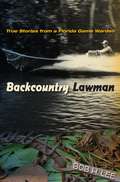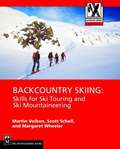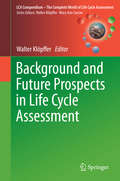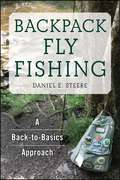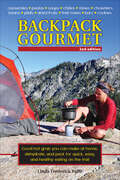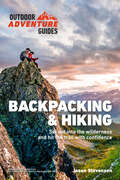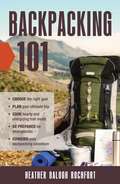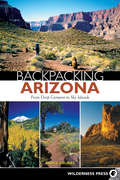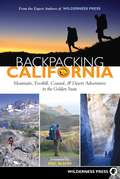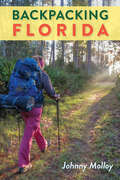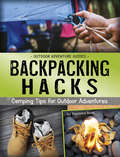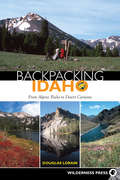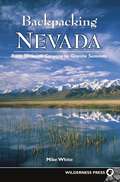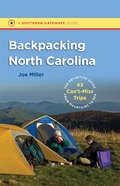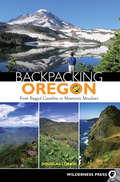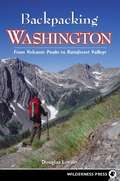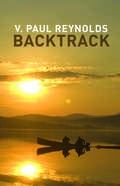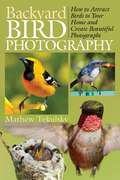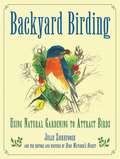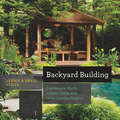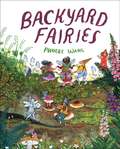- Table View
- List View
Backcountry Lawman: True Stories from a Florida Game Warden (Florida History and Culture)
by Bob H. LeeWith thirty years of backcountry patrol experience in Florida, Bob Lee has lived through incidents of legend, including one of the biggest environmental busts in Florida history. His fascinating memoir reveals the danger and the humor in the unsung exploits of game wardens.
Backcountry Skiing: Skills for Ski Touring and Ski Mountaineering
by Martin Volken Scott Schell Margaret WheelerThe authors provide skiers with the tools and knowledge they need to safely and successfully travel in the mountains. The guide features intermediate-to-advanced techniques for ski touring and ski mountaineering, from planning wilderness trips to perfecting turns in rolling terrain and mastering uphill climbing. For those skiers ready for a more technical, high alpine environment, they draw on traditional mountaineering skills, including roped climbing, setting protection anchors, using ice axes, climbing on bare rock, and more.
Background and Future Prospects in Life Cycle Assessment (LCA Compendium – The Complete World of Life Cycle Assessment)
by Walter KlöpfferLife Cycle Assessment (LCA) has become the recognized instrument to assess the ecological burdens and human health impacts connected with the complete life cycle (creation, use, end-of-life) of products, processes and activities, enabling the assessor to model the entire system from which products are derived or in which processes and activities operate. This volume introduces the major new book series LCA Compendium - The Complete World of Life Cycle Assessment. In this volume, the main drivers in the development of LCA are explored. The volume also discusses strengths and limitations in LCA as well as challenges and gaps, thus offering an unbiased picture of the state-of-the-art and future of LCA.
Backpack Fly Fishing: A Back-to-Basics Approach
by Daniel E SteereTips for simplifying fly-fishing trips to fish more often and in more locations.Increasingly, the trend in fly fishing has been toward greater specialization (trout vs. bass, freshwater vs. saltwater, lightweight vs. heavier weight rods and reels) and complexity. This trend has taken many anglers away from what they loved best about fly-fishing: catching a wide variety of fish with simple, minimalist equipment that can fit into a daypack. Backpack Fly Fishing helps readers to understand why we need to get back to a simpler approach and how to enjoy doing it.In Backpack Fly Fishing, Daniel E. Steere provides a comprehensive philosophy for this back-to-basics approach to fishing. He includes chapters on equipment selection, fish that can be caught using this equipment and how to catch them, how to approach different types of waters, and important flies and how to tie them. Additional chapters address how backpack fly-fishing fits into the context of other outdoor activities such as camping, hiking, and birding.Everyone can benefit from Steere’s helpful information, including current flyfishermen who want to try a less complicated, back-to-basics approach; spin and bait fishermen who want to try the sport of fly fishing without breaking the bank on fishing equipment; and hikers, campers, bicyclists, and other outdoors people who want to be able to fish in waters that they may happen upon during their journeys through the wilds.Skyhorse Publishing is proud to publish a broad range of books for fishermen. Our books for anglers include titles that focus on fly fishing, bait fishing, fly-casting, spin casting, deep sea fishing, and surf fishing. Our books offer both practical advice on tackle, techniques, knots, and more, as well as lyrical prose on fishing for bass, trout, salmon, crappie, baitfish, catfish, and more. While not every title we publish becomes a New York Times bestseller or a national bestseller, we are committed to publishing books on subjects that are sometimes overlooked by other publishers and to authors whose work might not otherwise find a home.
Backpack Gourmet: Good Hot Grub You Can Make at Home, Dehydrate, and Pack for Quick, Easy, and Healthy Eating on the Trail
by Linda Frederick Yaffe&“Recipes for hikers seeking an alternative to the expensive, often boring, freeze-dried prepared meals that are sold in stores.&” —Library Journal Improve your backpacking experience by creating the delicious and healthy home-dried meals and snacks featured in this book. Easy to rehydrate in camp and lighter than lugging ingredients and extra fuel, these foods are perfect for backpackers. Updated with twenty brand-new recipes, including Sesame Lasagna, Stuffed Cabbage Soup, San Antonio Special, and Backpacker&’s Cincinnati Chili, this new edition also has the most up-to-date information on dehydrators and stoves, water purification, and food storage, making it the perfect handbook for nutritious—and delectable—dining on the trail. · Over 180 recipes for casseroles, pastas, soups, stews, chowders, beans, pilafs, dried fruits, trail mixes, bars, and cookies · Tips on drying food in a dehydrator or oven · Includes vegetarian and low-fat recipes · Recipes so tasty that you'll make them at home too!
Backpacking & Hiking: Set Out into the Wilderness and Hit the Trail with Confidence (Outdoor Adventure Guide)
by Jason StevensonHit the trails with all the backpacking and hiking information you needYou know there's nothing quite like spending time with nature, enjoying the fresh air and magnificent vistas. But thinking about where to go, what to bring, and how to protect yourself from the elements might have you feeling less adventurous than you'd like. Well, it's time to get off the couch and onto the trail with Outdoor Adventure Guides: Backpacking and Hiking. Filled with practical tips, this guide gives you all the information you need to survive and thrive in the great outdoors.Packed with information ranging from preparing your body and choosing what to bring to handling the elements and knowing your first aid, this no-nonsense guide has everything you've been looking for in a trail buddy--and its travel-friendly size means it fits in any backpack you bring!So what are you waiting for? Go have an adventure!
Backpacking (Merit Badge Series)
by Boy Scouts of AmericaThis book in the Merit Badge series explains basic guidelines for backpacking. It covers basic first aid, clothing, etc, necessary for a backpacking trip.
Backpacking 101: Choose the Right Gear, Plan Your Ultimate Trip, Cook Hearty and Energizing Trail Meals, Be Prepared for Emergencies, Conquer Your Backpacking Adventures
by Heather Balogh RochfortFrom the creator of the Just a Colorado Gal blog comes a guide to help you plan for a fun backpacking experience.It’s time to take a hike! In Backpacking 101, outdoor expert Heather Balogh Rochfort goes step-by-step through the preparation process of hiking—from selecting the right gear to choosing the perfect destination. She also provides useful information for out on the trail, including how to -Properly read a topographic map -Set up an environmentally friendly campsite -Safely interact with wildlife -Handle being lost in the woods With Backpacking 101 in your bag, you can be prepared for whatever comes your way during your trek—no matter what skill level you are. It’s the perfect resource for anyone ready for an outdoor adventure!
Backpacking Arizona
by Bruce GrubbsThe world-famous Grand Canyon is only one of Arizona's spectacular natural features. Arizona encompasses over 90 wilderness areas, more than 15 national parks and monuments, and the largest national forest in the country. Expansive mesas, high peaks, and snaking canyons create a dynamic landscape and reflect a rich geologic and human history. Backpacking Arizona is the only guide devoted to overnight trips in the state. You'll discover the maze of side canyons and hidden grottos in the Grand Canyon's untrammeled backcountry, historic pioneer trails on the Mogollon Rim, the little-traveled Blue Range, and the legendary Superstition Mountains in the Sonoran Desert.
Backpacking California
by Wilderness PressBackpacking California is a collection of more than 70 of the most intriguing backpacking adventures in Wilderness Press's home territory of California. With contributions from more than a dozen Wilderness Press authors, the book describes routes ranging from one night to one week. Backpacking novices as well as "old hand" California hikers will find expert-crafted trips in the Coast Ranges, the Sierra, the Cascades, and the Warner Mountains. Expanded coverage includes trips in Big Sur, Anza-Borrego, Death Valley, and the White Mountains. Several trips have been described in print nowhere else. Each trip includes a trail map and essential logistical information for trip planning.
Backpacking Florida
by Johnny MolloyThe essential guide to Florida’s best overnight hiking trips From the coastal bluffs of the Panhandle to the wild Everglades, Backpacking Florida features 40 overnight trail adventures covering a total of 600 miles across the state. Expert outdoorsman Johnny Molloy provides readers with the tools and information they need to unplug and experience Florida’s amazing variety of ecosystems up close. Destinations in this guide range from well-known, “must-do” spots like Juniper Prairie Wilderness, Rice Creek Conservation Area, and the Blackwater River State Forest to undiscovered gems like Jennings State Forest, Ocklawaha Prairie Restoration Area, and Bonnet Pond. Trails are categorized by region, difficulty, and length, from 3-mile family treks to 50-mile larger-than-life excursions, resulting in a useful guide for both novice and experienced backpackers. For every trail, Molloy includes a map and mileage chart and explains how to get to the trailhead, where the campsites are, and what hikers will see along the way. Readers will also find helpful advice on topics such as selecting a campsite and food for the trail. Backpacking Florida is an invaluable resource for planning and enjoying the perfect Florida outdoor adventure.
Backpacking Hacks: Camping Tips for Outdoor Adventures (Outdoor Adventure Guides)
by Raymond BeanDon't just survive, thrive in the great outdoors! This handy guidebook provides unique tips and tricks to transform any camping trip into a glamping vacay, including defense against weather extremes, hygiene hacks, and unplugged entertainment options. With bold photos and infographics, step-by-step projects, and expert instructions, OUTDOOR ADVENTURE GUIDES will have first-time campers and enthusiasts alike opting outside.
Backpacking Idaho
by Douglas LorainA virtually undiscovered backpacking paradise, Idaho has numerous wilderness areas of mind-boggling size. Backpackers can find complete solitude, wildlife, and some of North America's most outstanding scenery. Idaho's mountains also boast great weather--fewer thunderstorms than the central Rockies, less rain than Oregon and Washington, and cooler summer temperatures than California. Backpacking Idaho takes you to what author Doug Lorain calls a "Shangri-la" for backpackers. In the craggy Selkirk Mountains you'll find lush forests, small cirque lakes, and jagged granite peaks. Watch for ospreys, river otters, and belted kingfishers in the swift Selway River. Explore hundreds of miles of trails in the gently rolling forested hills in north-central Idaho, or head to Hell's Canyon, the deepest gorge in North America, where you'll find both alpine tundra and cactus-studded desert.
Backpacking Nevada
by Mike WhiteBackpacking Nevada, the ultimate guide to backpacking trips in Nevada's basin and range, has 23 trips ranging from two days to two weeks. From the East Humboldt Wilderness to the Ruby Mountains and the Toiyabe Range, this guide describes the finest backpacking adventures in Nevada. Few people are aware of the vast expanse of natural beauty that lies outside the dizzying atmosphere of Nevada's Las Vegas and Reno metro areas. Venture outside the strip however, and discover untrammeled wilderness in the most mountainous state in the continental US. Explore the forests of the Carson Range, traverse the granite peaks and cascading creeks of the Santa Rosa-Paradise Peak Wilderness, or watch elk and antelope in the remote Jarbridge Mountains.
Backpacking North Carolina
by Joe MillerJoe Miller brings us the first-ever stand-alone guidebook to backpacking in North Carolina, a state long known as a terrific backpacking destination. Covering 43 of the best trips the state has to offer,Backpacking North Carolinaprovides all the information necessary for beginning and experienced backpackers alike to enjoy hiking destinations from the mountains to the coast. Each trip description offers key maps and navigation information, including water sources and camping spots, as well as trip highlights and special considerations. Miller offers tips for enriching the experience, such as filling dark nights with stargazing and other activities, and gives advice for backpacking with children. Offering his expertise in a way that emphasizes the accessibility of backpacking, Miller encourages a wide range of nature lovers to give it a try, perhaps for the first time. Several "best-of" lists are included, featuring trips with exceptional nature study opportunities, water recreation, and easy excursions for beginners. Backpacking North Carolinatakes the reader deep into a state full of natural wonder and adventure. Backpacking North Carolinahas all the essentials for planning your trip, whether a quick weekend getaway or a longer adventure: "Trips for beginner and expert backpackers alike "Helpful essays to introduce each trail and its features "Gear and safety advice for year-round backpacking "Major points of interest highlighted on each trip "Family-friendly trails and easy bailouts for when hiking with children "Detailed trail maps and directions to trailheads "Elevation profiles for each hike "Estimated hike times and level of difficulty "Camping permit requirements "GPS coordinates for water sources and good camping spots "Bullet lists of best trips for fishing, bird watching, waterfalls, and more
Backpacking Oregon
by Douglas LorainIn Oregon, backpackers can hike wild beaches, enjoy colorful desert canyonlands, walk amid stunning granite peaks, relax in wildflower meadows, and circle glacier-clad mountains. Award-winning guidebook author and longtime Oregon resident Douglas Lorain details 30 spectacular backpacking trips in Backpacking Oregon. Lasting from three days to two weeks, these carefully crafted itineraries offer geographic diversity, beautiful scenery, and reasonable daily mileage goals. This in-depth guide provides all the information backpackers will need to access the Oregon backcountry, including the Oregon Coast, Columbia Gorge, High Cascades, Hells Canyon, and the Klamath, Siskiyou, Blue, and Wallowa mountains. A detailed trail map and photographs accompany each trip.
Backpacking Washington
by Douglas LorainNow completely updated for a second edition, Backpacking Washington remains the only comprehensive guide to all of the Evergreen State's best extended backpacking trips. Ranging from three days to two weeks, these 28 adventures visit every corner of the state, including the wild beaches of the Olympic Peninsula, the vast interior of the Pasayten Wilderness, Mt. Rainier's famous Wonderland Trail, the volcanic wasteland around Mt. St. Helens, and the little-known Salmo-Priest Wilderness, where hikers may glimpse grizzly bears.
Backpacking Wyoming
by Douglas LorainWyoming boasts countless outstanding backcountry destinations. While some of these attractions are world famous, many are virtually unknown even to the savviest locals. Award-winning author Douglas Lorain details both famous and hidden treasures in his picks of Wyoming's 28 most enjoyable backpack trips. Lasting from three days to two weeks, these carefully chosen itineraries offer the hiker mountain scenery, magnificent wildlife, colorful geologic marvels, and reasonable daily mileage goals. This in-depth guide reveals the best trips in and around Yellowstone and Grand Teton National Parks, the Beartooth and Bighorn Mountains, the Absaroka and Snowy Ranges, the Wind River Range, and such treasures as the Wyoming, Gros Ventre, Bear Lodge, and Salt River Mountains. Each of the trips rates scenery, solitude, and difficulty; specifies mileage, elevation gain, days on the trail, and shuttle distance; and notes special attractions, required permits, and challenges. A detailed map and photographs accompany each trip. Everything the backcountry adventurer needs for a "trip of a lifetime."
Backtrack
by V. Paul ReynoldsIn Backtrack, former naval officer, avid outdoorsman, sportsman, editor, and award-winning journal- ist V. Paul Reynolds journeys back along the path of his life to revisit and share with readers many of his outdoor experiences. Reynolds was introduced to the outdoors by his father, Harvard Reynolds, in the 1940s. Harvard took his son to many of his own favorite hunt- ing and fishing spots, helping give birth to his son's lifelong love affair with the outdoors. Later, Harvard eventually took his son to his first smoke-filled hunting camp, where amber liquid flowed and profanity filled the room. Reynolds would soon understood how the out- doors could bestow both the love of nature and the joy of friendship. Reynolds' journey has since car- ried him from the brooks of Maine to hunting grounds across North America, as well as indoors to the hallways of Augusta, where he worked for the Maine Department of Inland Fisheries and Wildlife, and the editorial offices of the Northwoods Sporting Journal where he serves editor and publisher. Reynolds' life has been a great outdoor adventure; now the eloquent and thoughtful writer brings readers along on the trail to skin a deer in the field, fish with his dad, and hunt with his wife, Diane, herself a dedicated outdoorswoman.
Backyard Bears: Conservation, Habitat Changes, and the Rise of Urban Wildlife (Scientists in the Field Series)
by Amy CherrixNorth Carolina's black bears were once a threatened species, but now their numbers are rising in and around Asheville. But what happens when conservation efforts for a species are so successful that there’s a boom in the population? Can humans and bears live compatibly? What are the long-term effects for the bears? Author Amy Cherrix follows the scientists who, in cooperation with local citizen scientists, are trying to answer to these questions and more. Part field science, part conservation science, Backyard Bears looks at black bears—and other animals around the globe—who are rapidly becoming our neighbors in urban and suburban areas.What happens when conservation efforts for a species are so successful that there’s a boom in the population? Part field science, part conservation science, Backyard Bears looks at black bears—and other animals around the globe—who are rapidly becoming our neighbors in urban and suburban areas. North Carolina's black bears were once a threatened species, but now their numbers are rising in and around Asheville. Can humans and bears live compatibly? What are the long-term effects for the bears? Author Amy Cherrix follows the scientists who, in cooperation with local citizens, are trying to answer to these questions and more.
Backyard Bird Photography: How to Attract Birds to Your Home and Create Beautiful Photographs
by Mathew TekulskyFans of bird watching will rejoice with Backyard Bird Photography, a guide for learning how to set up your backyard in order to take the best photographs of your local birds. In addition to guiding you through the first steps of setting up your plantings and bird feeders, this book describes the types of photographic equipment you will need to get just the right image; how to maneuver yourself into just the right position to create a quality bird photograph; how to compose your shots for the greatest visual effect; and how to use more advanced techniques such as macro lenses and external flash techniques.Author and bird photographer Mathew Tekulsky breaks down the challenges of photographing these beautiful creatures and explains how utilizing your own natural surroundings can create stunning shots that rival those shot in the wild. Tekulsky explains that when your garden is set up as a tiny oasis for these feathered friends--with the right foliage, water sources, and feeders--then your backyard will be frequented by a variety of species on any given day. With tips for gaining the bird's trust and composition, every photograph will come out a stunner.
Backyard Bird Song: Eastern and Central North America (Peterson's Field Guides)
by Robert Lawson Richard K. Walton"Backyard Bird Song introduces you to the fascinating world of bird song. Used in conjunction with my Field Guide to the Birds, this audio guide may give you a new perspective on a familiar place, your own backyard. "In this audio guide, Dick Walton and Bob Lawson have grouped 28 of the most common bird species according to similarity of song. Just as my Field Guide shows what to look for, Backyard Bird Song points out exactly what to listen for to tell one bird from another." -Roger Tory Peterson With this audio guide, you can learn to identify your favorite birds by their songs and calls alone. Backyard Bird Song includes 28 of the most common backyard birds, such as the American Robin, Song Sparrow, and the Downy Woodpecker, arranged in groups with similar vocalizations.
Backyard Birding: Using Natural Gardening to Attract Birds (Rodale Organic Gardening Book Ser.)
by Julie ZickefooseBird watchers everywhere dream of a landscape filled with berry-laden branches, nesting spots among twining vines, and birds crowding their feeding stations. Let "Backyard Birding" show you how to lay out the welcome mat for your feathered friends by considering all of their needs, including year-round water, food, and shelter. Whether youOCOre looking to create a hummingbird garden, install a water feature, create perches for birds, or simply let a corner of your property run wild, youOCOll find all of the inspiration and information you need here in "Backyard Birding. ""
Backyard Building: Treehouses, Sheds, Arbors, Gates, and Other Garden Projects (Know How)
by Jean Stiles David StilesHere is the very best of backyard building: Popular building authors Jeanie and David Stiles--whose treehouse once garnered a spread in Architectural Digest--have gathered dozens of original plans for treehouses, playhouses, and sheds, as well as a summer house, tea house, garden arbor, and functional workroom. Backyard Building will cover backyard accessories, the fundamentals of tools and materials, and useful tips based on real-life questions from the couple's popular website. Its unique style, with hand-drawn illustrations to guide the reader through the building process in a user-friendly way, stands out from the crowd. The clear, detailed drawings are not only easy to follow but a pleasure to look at; they are supplemented by irresistible color photographs.
Backyard Fairies
by Phoebe WahlFairies are real, and they're all around us! Award-winning author-illustrator Phoebe Wahl offers a fanciful and beautifully illustrated peek into the hidden world of fairies, sprites, and other magical creatures.A girl searches for fairies in her backyard and the woods beyond, following little clues and traces of magic. Fairies and other magical creatures can be found on every page, hidden among the flowers, trees and pebbles. But although readers can see them, the girl keeps searching, just one step behind... In the end, it is clear (both to the girl and readers) that there is magic all around, even when it's hidden in plain sight. Phoebe Wahl takes us deep into the world of fairies, and her vibrant, multi-textured woodland scenes are every bit as enchanting as the creatures therein. A gorgeously illustrated paean to imagination and the natural world."Delightful . . . This gently magical outing will appeal not only to longtime lovers of European folklore, but also to fans of the popular "fairy door" phenomenon."--Kirkus Reviews
